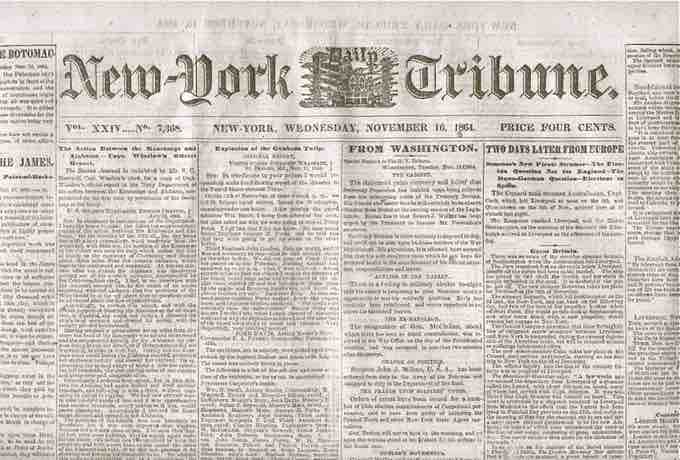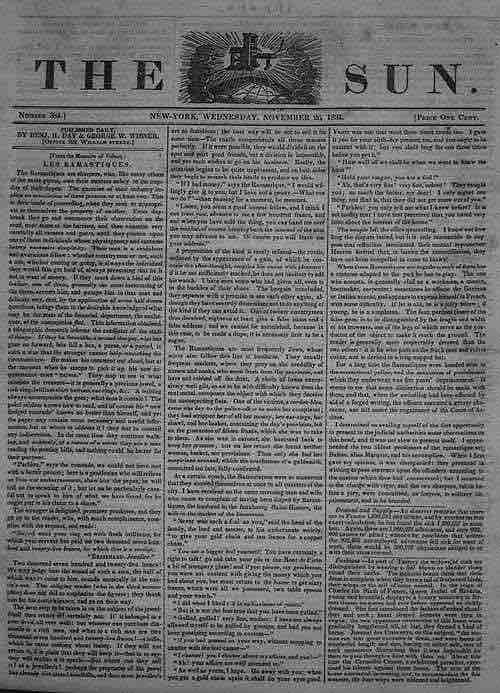Introduction
During the middle of the nineteenth century, newspapers changed from being mouthpieces of political parties to serving a broader public appeal. Many of the changes that came with this shift brought about new features of journalism that remain important today, such as the editorial page, personal interviews, business news, and foreign-news correspondents.
Many newspapers in the early part of the nineteenth century were published by political parties and served as political mouthpieces for the beliefs and candidates of those parties. Over the next few decades, however, the influence of these "administrative organs" began to fade away. Newspapers and their editors began to show greater personal and editorial influence as they realized the broader appeal of human-interest stories.

November 16, 1864 edition of the New York Tribune
Some penny papers were closely associated with political parties; the New York Tribune backed the Whigs and later the Republicans.
Birth of Editorial Comment
The editorial voice of each newspaper grew more distinct and important, and the editorial page began to assume something of its modern form. The editorial signed with a pseudonym gradually died, but unsigned editorial comment and leading articles did not become established features until after 1814, when Nathan Hale made them characteristic of the newly established Boston Daily Advertiser. From then on, these features grew in importance until they became the most vital part of the greater papers.
News Becomes Widespread
Nearly every county and large town sponsored at least one weekly newspaper. Politics were of major interest, with the editor-owner typically deeply involved in local party organizations. However, the papers also contained local news, and presented literary columns and book excerpts that catered to an emerging middle class and literate audience. A typical rural newspaper provided its readers with a substantial source of national and international news and political commentary, typically reprinted from metropolitan newspapers. In addition, the major metropolitan dailies often prepared weekly editions for circulation to the countryside.
Systems of more rapid news-gathering and distribution quickly appeared. The telegraph, put to successful use during the Mexican-American War, led to numerous far-reaching results in journalism. Its greatest effect was to decentralize the press by rendering the inland papers (in such cities as Chicago, Louisville, Cincinnati, and New Orleans) independent of those in Washington and New York. The news field was immeasurably broadened; news style was improved, and the introduction of interviews, with their dialogue and direct quotations, imparted papers with an ease and freshness. There was a notable improvement in the reporting of business, markets, and finance. A foreign-news service was developed that reached the highest standard yet attained in American journalism in terms of intelligence and general excellence.
This idea of the newspaper for its own sake, the unprecedented aggressiveness in news-gathering, and the blatant methods by which the cheap papers were popularized, aroused the antagonism of the older papers, but created a competition that could not be ignored. The growth of these newer papers meant the development of great staffs of workers that exceeded in numbers anything dreamed of in the preceding period. Indeed, the years between 1840 and 1860 saw the beginnings of the scope, complexity, and excellence of our modern journalism.
The Penny Press
Background
In the early 1800s, newspapers had catered largely to the elite and took two forms: mercantile sheets that were intended for the business community and contained ship schedules, wholesale product prices, advertisements and some stale foreign news; and political newspapers that were controlled by political parties or their editors as a means of sharing their views with elite stakeholders. Journalists reported the party line and editorialized in favor of party positions.
Appealing to the Commoner
Some editors believed in a public who would not buy a serious paper at any price; they believed the common person had a vast and indiscriminate curiosity better satisfied with gossip than discussion and with sensation rather than fact, and who could be reached through their appetites and passions. To this end, the "penny press" papers, which sold for one cent per copy, were introduced in the 1830s. Penny press newspapers became an important form of popular entertainment in the mid-nineteenth century, taking the form of cheap, tabloid-style papers. As the East Coast's middle and working classes grew, so did the new public's desire for news, and penny papers emerged as a cheap source that covered crime, tragedy, adventure, and gossip. They depended much more on advertising than on high priced subscriptions, and they often aimed their articles at broad public interests instead of at perceived upper-class tastes.
Mass production of inexpensive newspapers became possible when technology shifted from handcrafted to steam-powered printing. The penny paper was famous for costing one cent, unlike its competitors, which could cost as much as six cents. This cheap newspaper was revolutionary because it made the news available to lower-class citizens for a reasonable price. To be profitable at such a low price, these papers needed large circulations and feature advertisements; they needed to target a public who had not been accustomed to buying papers and who would be attracted by news of the street, shop, and factory.
The Sun and the Herald
Benjamin Day, an important and innovative publisher of penny newspapers, introduced a new type of sensationalism: a reliance on human-interest stories. He emphasized common people as they were reflected in the political, educational, and social life of the day. Day also introduced a new way of selling papers, known as the London Plan, in which newsboys hawked their newspapers on the streets. Penny papers hired reporters and correspondents to seek out and write the news, and the news began to sound more journalistic than editorial. Reporters were assigned to beats and were involved in the conduct of local interaction.

The newspaper, The New York Sun
Benjamin Day's newspaper, The New York Sun.
James Gordon Bennett's newspaper The New York Herald added another dimension to penny press papers that is now common in journalistic practice. Whereas newspapers had generally relied on documents as sources, Bennett introduced the practices of observation and interviewing to provide stories with more vivid details. Bennett is known for redefining the concept of news, reorganizing the news business, and introducing newspaper competition. The New York Herald was financially independent of politicians because it had large numbers of advertisers.
Abolition: A Thorny Issue
In a period of widespread unrest and social change, many specialized forms of journalism sprang up, focusing on religious, educational, agricultural, and commercial themes. During this time, workingmen were questioning the justice of existing economic systems and raising a new labor issues; Unitarianism and transcendentalism were creating and expressing new spiritual values; temperance, prohibition, and the political status of women were being discussed; and abolitionists were growing more vocal, becoming the subject of controversy most critically related to journalism. Some reform movements published their own newspapers, and abolitionist papers in particular were met with a great deal of controversy as they rallied against slavery.
The abolitionist press, which began with The Emancipator of 1820 and had its chief representative in William Lloyd Garrison's Liberator, forced the slavery question upon the newspapers, and a struggle for the freedom of the press ensued. Many abolitionist papers were excluded from the mails, and their circulation was forcibly prevented in the South. In Boston, New York, Baltimore, Cincinnati, and elsewhere, editors were assaulted, and offices were attacked and destroyed.